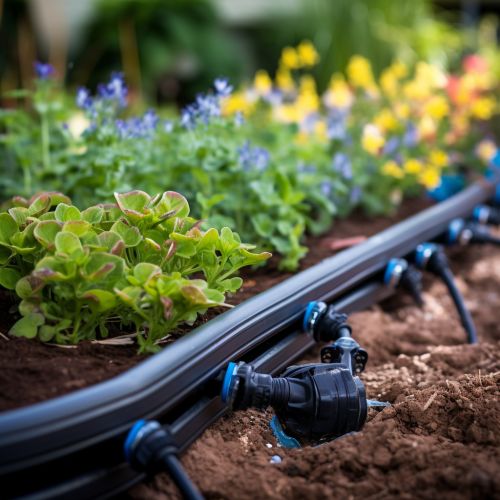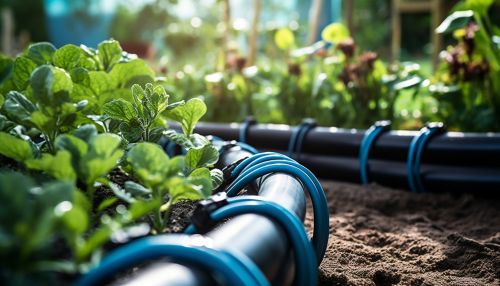Drip irrigation
Introduction
Drip irrigation, also known as trickle irrigation or micro-irrigation, is a method of irrigation that allows water to drip slowly to the roots of plants, either from above the soil surface or buried below the surface. The goal is to place water directly into the root zone and minimize evaporation. Drip irrigation systems distribute water through a network of valves, pipes, tubing, and emitters. Depending on how well designed, installed, maintained, and operated it is, a drip irrigation system can be more efficient than other types of irrigation systems, such as surface irrigation or sprinkler irrigation.


History
Modern drip irrigation began in the 1860s when researchers began experimenting with irrigation using clay pipe to create combination irrigation and drainage systems. It was not until the mid-20th century that plastics allowed for the creation of more efficient and effective drip irrigation systems. The first experimental system of this type was established by Simcha Blass in conjunction with the Israeli government in 1959. The success of these early systems led to further research and the eventual commercialization of drip irrigation technology.
Principles
Drip irrigation works on the basic principle of irrigating only the root zone instead of the entire field surface, thus making water available directly to the plant roots. The water is then used most efficiently as the surface area of wetted soil is reduced, and therefore, the loss of water due to evaporation is also minimized.
Components
A typical drip irrigation system consists of the following components:
- Water source: This could be a well, pond, river, or a municipal water supply. The water source should be clean and free from any sediments or contaminants that could block the emitters.
- Pump unit: The pump unit is used to pressurize the water. The type of pump used depends on the water source and the required pressure.
- Mainline/Manifold: This is the PVC pipe or polyethylene tubing that carries water from the pump to the laterals.
- Laterals: These are small diameter pipes fitted with emitters that deliver water directly to the plant roots. They are usually made of polyethylene or vinyl and can be laid on the ground surface or buried below the surface.
- Emitters/Drippers: These are devices that emit water in a slow and steady manner. They are designed to deliver water at a specific flow rate, which can vary from 0.5 to 4 gallons per hour.
- Filters: Filters are used to remove any sediments or contaminants from the water to prevent clogging of the emitters.
- Pressure regulators: These are used to reduce and regulate the pressure of water entering the system.
- Backflow preventers: These are used to prevent the reverse flow of water, which could contaminate the water source.
- Valves: Valves are used to control the flow of water in the system. They can be manual or automatic.
Types of Drip Irrigation Systems
There are several types of drip irrigation systems, each with its own set of advantages and disadvantages. The most common types include:
- Surface Drip System: In this system, the drip lines are laid on the soil surface. This is the most common type of drip irrigation system and is typically used in row crops and gardens.
- Subsurface Drip System: In this system, the drip lines are buried below the soil surface. This type of system is used in perennial crops such as vineyards and orchards, and in landscapes where aesthetics are important.
- Bubbler Drip System: This system uses bubblers that deliver water directly to the root zone of individual plants. It is typically used in tree and shrub plantings.
- Micro-spray Drip System: This system uses micro-sprayers or micro-sprinklers that spray water in a small area. It is typically used in orchards and vineyards.
Advantages and Disadvantages
Like any other irrigation method, drip irrigation has its advantages and disadvantages.
Advantages
- Efficiency: Drip irrigation is highly efficient as it delivers water directly to the plant roots, reducing evaporation and runoff.
- Water Conservation: By reducing evaporation and runoff, drip irrigation conserves water.
- Fertilizer Efficiency: Fertilizers can be applied directly to the plant roots, improving their uptake and reducing leaching.
- Reduced Weed Growth: By watering only the plant roots, drip irrigation reduces the growth of weeds.
- Flexibility: Drip irrigation systems can be customized to fit any landscape and can be easily adjusted as plants grow and needs change.
Disadvantages
- Initial Cost: The initial cost of installing a drip irrigation system can be high.
- Maintenance: Drip irrigation systems require regular maintenance to prevent clogging of the emitters.
- Limited Lifespan: The components of a drip irrigation system, especially the emitters and tubing, have a limited lifespan and need to be replaced periodically.
- Risk of Root Diseases: If not properly managed, drip irrigation can increase the risk of root diseases due to the constant wetting of the soil.
Design Considerations
Designing a drip irrigation system requires careful consideration of several factors, including:
- Water Source: The quality and quantity of the water source should be assessed. The water should be free from sediments and contaminants that could clog the emitters.
- Plant Needs: The water and nutrient needs of the plants should be determined. Different plants have different water and nutrient requirements, and these should be taken into account when designing the system.
- Soil Type: The type of soil affects the rate at which water is absorbed and the distance it can travel in the soil. Sandy soils absorb water quickly but have a low water holding capacity, while clay soils absorb water slowly but have a high water holding capacity.
- Topography: The topography of the land affects the design of the system. Sloping land may require pressure compensating emitters to ensure uniform water distribution.
- Climate: The climate affects the water needs of the plants and the evaporation rate. In hot and dry climates, more frequent irrigation may be required.
Installation and Maintenance
The installation of a drip irrigation system involves laying out the mainline and laterals, installing the emitters, and connecting the system to the water source and the pump. Once installed, the system requires regular maintenance to ensure its efficient operation. This includes cleaning the filters, checking the emitters for clogging, and monitoring the system for leaks.
Environmental Impact
Drip irrigation has a positive environmental impact as it conserves water and reduces the leaching of fertilizers into the groundwater. However, it also has some negative impacts, such as the use of plastic materials in the system and the energy required to pump the water.
